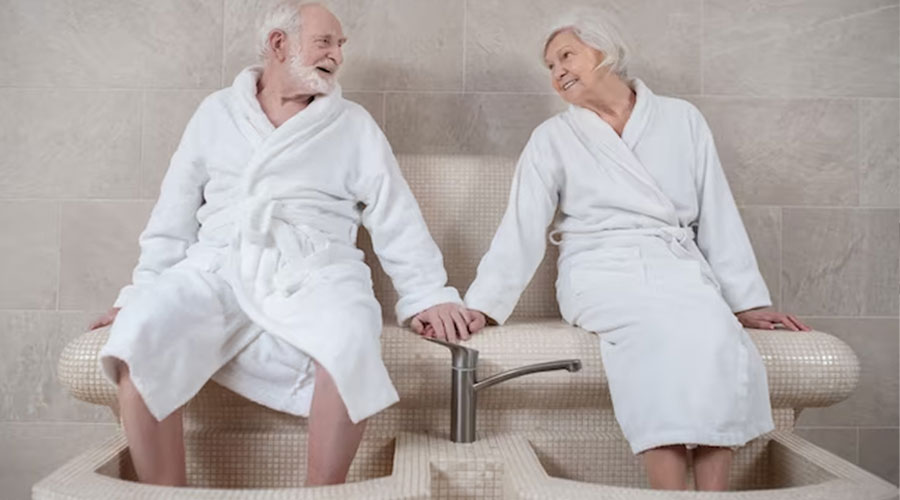Welcome to our comprehensive guide to walk-in baths!
If you or your loved ones are facing mobility challenges or desire a more accessible bathing experience, walk-in baths can be a game-changer. Here, you will explore the walk-in baths guide - benefits, costs, safety considerations, essential features, and a comparison to traditional bathtubs. We can aid in discovering how walk-in baths can revolutionize your everyday routine, offering comfort, independence, and complete peace of mind. Join us as we navigate through the world of walk-in baths, empowering you to make informed decisions that prioritize your well-being and enhance your bathroom sanctuary.
So, let's begin with some most common things about walk in baths you want to know, including –
1. What are the benefits of using a walk-in bath for seniors and people with mobility issues?
2. How do walk-in baths work, and what features should I look for when choosing one?
3. Are walk-in baths safe and accessible for all individuals, including those with disabilities?
4. What is the average cost of installing a walk-in bath, and are any affordable options available?
5. Can a walk-in bath be a suitable replacement for a traditional bathtub in terms of functionality and aesthetics?
Here is the detailed answer for all the above queries.
1. Benefits of using a walk-in bath for seniors and people with mobility issues ?
Walk-in baths have become increasingly popular as an accessible and convenient bathing solution for seniors and individuals with mobility challenges.
Improved Safety and Accessibility
One of the primary advantages of walk-in baths is their enhanced safety. Traditional bathtubs can pose a significant risk for seniors and people with mobility issues, as stepping over the high edge can lead to slips and falls. Walk-in baths offer a low entrance and a door that opens outward, letting users enter and exit without lifting their legs. The built-in handrails further enhance stability, reducing the chances of accidents and injuries during bathing.
Therapeutic Benefits
Walk-in baths often have therapeutic features such as hydrotherapy jets and heated seating. With hydrotherapy, one can get soothing relief from arthritis, joint pain, or muscle aches. The warm water and massaging jets can aid improve blood circulation, reduce stress, and promote relaxation.
Independence and Dignity
For individuals with limited mobility, the capability to bathe alone is crucial for masking them feel their self-worth and a sense of dignity. Walk-in baths empower users to take care of their personal hygiene without assistance, promoting a higher level of independence and reducing the need for caregiver assistance.
Easy Installation and Retrofitting
Walk-in baths are designed to fit into standard bathtub spaces, making them a feasible option for renovations. They can be installed quickly and may not need extensive alterations to the existing plumbing, which helps save on installation costs.
Increasing Property Value
As the population ages and more people seek accessible living solutions, walk-in baths have become desirable features for potential homebuyers. Installing a walk-in bath can add value to a property, making it an attractive investment for homeowners.
Walk-in baths offer a plethora of benefits for seniors and individuals with mobility issues. From improved safety and therapeutic benefits to promoting independence and increasing property value, these baths have proven valuable additions to any accessible bathroom. By prioritizing the well-being and comfort of those with limited mobility, walk-in baths continue to be a significant innovation in bathroom design.
2. How do walk-in baths work, and what features should I look for when choosing one?
Walk-in baths are specialized bathtubs designed to enhance safety and accessibility for users, particularly seniors and people with mobility challenges.
How Walk-In Baths Work
Walk-in baths function like traditional bathtubs but comprise numerous features that make them safer and more user-friendly. The primary component is the watertight door, allowing easy entry and exit without lifting the legs over the high tub walls. The door has a secure locking mechanism to prevent leaks during use.
Inside the walk-in bath are often built-in seating areas, handrails, and anti-slip flooring to provide stability and support for users. Many walk-in baths also offer therapeutic features such as hydrotherapy jets, air jets, or whirlpool systems that provide relaxing massages and relief for muscle tension and joint pain.
Walk in Baths Guide: Key Features to Consider
- Size and Configuration
Walk-in baths come in various sizes and configurations to accommodate different bathroom spaces and user preferences. It's essential to measure the available space in your bathroom and choose a walk-in bath that fits appropriately. - Door Type
Walk-in baths offer inward or outward opening doors. Outward-opening doors are generally more accessible and easier to use, especially in emergencies when assistance is required. - Accessibility Options
Look for walk-in baths with low step-in heights to minimize the risk of tripping or falling. Additionally, consider models with ADA-compliant features such as grab bars and slip-resistant flooring for enhanced accessibility and safety. - Therapeutic Features
Many walk-in baths offer optional therapeutic features like hydrotherapy jets, air jets, or whirlpool systems. These features provide a soothing massage and promote relaxation, making your bathing experience more enjoyable and beneficial for your overall well-being. - Safety Measures
Ensure the walk-in bath has safety features such as non-slip flooring, ADA-compliant grab bars, and a secure door-locking mechanism. These elements are crucial for preventing accidents and maintaining stability during use. - Installation Requirements
Consider the installation requirements before purchasing a walk-in bath. Some models may require modifications to your bathroom's plumbing and electrical systems, while others can be easily retrofitted into existing bathtub spaces. It's essential to understand the installation process and associated costs. Walk-in baths offer a range of features that prioritize safety, accessibility, and user comfort. Knowing how these baths work and considering the key features mentioned above, you can get the best-suited walk-in baths.
3. "Are walk-in baths safe and accessible for all individuals, including those with disabilities?"
Walk-in baths have gained popularity for their enhanced safety and accessibility features. It is essential to know whether they are appropriate for elders and disabled people. Here, we address the safety and accessibility of walk-in baths, particularly for those with disabilities.
Safe and Accessible Design
Walk-in baths are designed safely and conveniently, making them apt for individuals with disabilities. They typically feature a low step-in height, allowing easy entry without lifting the legs over high tub walls. The watertight door provides a barrier-free access point, eliminating the risk of tripping or falling during entry and exit. To further enhance safety, walk-in baths often include non-slip flooring and ADA-compliant grab bars strategically placed for support and stability. These features help individuals with disabilities maintain balance and prevent accidents while bathing.
Accessibility Considerations
While walk-in baths offer improved accessibility compared to traditional bathtubs, it is crucial to consider individual needs and limitations. Some individuals with disabilities may require additional adaptations or accessories to make the bathing experience more comfortable and accessible.
For wheelchair users, it may be required to have a walk-in bath accommodating transfers from a wheelchair to the bath seat easily. This might include a wider door or additional space within the bath to allow for easy maneuvering and positioning.
Additionally, individuals with visual or cognitive disabilities may benefit from clear markings and intuitive controls on the bath's interface. User-friendly controls with high contrast and tactile feedback can make it easier for individuals to operate the walk-in bath independently.
It is essential to consult with healthcare professionals or accessibility experts to determine the specific requirements of individuals with disabilities and ensure that the chosen walk-in bath meets their unique needs.
Walk-in baths are usually safe and accessible for those with disabilities, thanks to their accessible design and protection features. However, it is crucial to consider individual requirements and consult with professionals to ensure the chosen walk-in bath meets specific accessibility needs. By doing so, individuals with disabilities can enjoy the benefits of a walk-in bath while maintaining safety and independence.
4. The average cost of installing a walk-in bath and affordable options available.
Installing a walk-in bath can provide a safe and convenient bathing solution for individuals with limited mobility. Also, consider the cost implications, and we can help to know the average cost of installing a walk-in bath and affordable options that can fit different budgets.
Average Cost of Installing a Walk-In Bath
The cost of installing a walk-in bath can vary depending on numerous factors, including the type of bath, added features, installation requirements, and location. Averagely, the cost of a walk-in bath installation of the unit with labor costs may come from $5,000 to $10,000. The cost may increase if extensive modifications to plumbing and electrical systems are required or if the bathroom needs structural changes to accommodate the walk-in bath. Multiple quotes from reputable suppliers and contractors are vital to get an accurate estimate based on your specific requirements.
Affordable Options
While walk-in baths can be a significant investment, affordable options cater to different budgets. Here are a few considerations
- Basic Models
Some manufacturers offer essential walk-in baths without extensive additional features. These models are often more affordable while providing the safety and accessibility features necessary for individuals with limited mobility. - Refurbished or Second-Hand Walk-In Baths
Consider purchasing a refurbished or second-hand walk-in bath. Reputable suppliers may offer these options at a lower cost while ensuring the quality and functionality of the unit. - Financial Assistance
Explore financial assistance programs and grants that may be available to help offset the cost of installing a walk-in bath. Organizations and government agencies often support individuals with disabilities or seniors who require accessibility modifications in their homes.
Financing Options
Many suppliers and contractors offer financing plans that let you pay for the walk-in bath in installments over time. Installing a walk-in bath can be a worthwhile investment for individuals with limited mobility, despite the associated costs. By understanding the average installation cost and exploring affordable options, such as basic models, refurbished units, financial assistance programs, and financing options, individuals can find a suitable walk-in bath that fits their budget while ensuring safety and accessibility in the bathroom.
5. "Can a walk-in bath be a suitable replacement for a traditional bathtub in terms of functionality and aesthetics?"
When considering a walk-in bath, many wonders if it can serve as a perfect and suited replacement for a traditional bathtub in terms of functionality and aesthetics. Let’s go through the functionality and aesthetics walk in bath offers.
Functionality
Walk-in baths enhance functionality and safety for individuals with limited mobility. In terms of functionality, walk-in baths excel in several areas
- Accessibility
Walk-in baths offer easy entry and exit without lifting the legs over high tub walls. The low step-in height and outward-opening door ensure that individuals with limited mobility can bathe independently and with reduced risk of accidents - Safety Features
Walk-in baths have safety features such as non-slip flooring, ADA-compliant grab bars, and secure locking mechanisms. These features ensure stability and reduce the risk of falls during bathing. - Therapeutic Benefits
Many walk-in baths include optional therapeutic features such as hydrotherapy, air jets, or whirlpool systems. These features provide relaxation and potential relief from muscle tension and joint pain, enhancing the bathing experience. - Customizations
Walk-in baths offer customization options, allowing individuals to choose features that best suit their needs. This includes adjustable seating, temperature controls, and additional accessories for convenience and comfort.
Aesthetics
Walk-in baths have come a long way in recent years regarding aesthetics. While they may not offer the same design options as traditional bathtubs, manufacturers now provide a fantastic range of colors, styles, and finishes to complement different bathroom aesthetics. Additionally, walk-in baths can be seamlessly integrated into existing bathroom spaces, preserving the overall design and ensuring a cohesive look. With the right choice of walk-in bath, it is possible to achieve a visually pleasing and functional bathroom.
Walk-in baths offer a high level of functionality and can serve as suitable replacements for traditional bathtubs, particularly for individuals with limited mobility.
With their accessibility features, safety measures, therapeutic benefits, and customization options, walk-in baths provide an excellent bathing solution that prioritizes both functionality and aesthetics and your overall needs.




